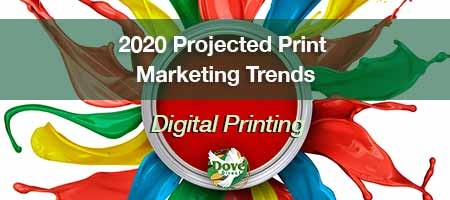Physical Versus Digital Complicates Decisions
Welcome to the Dove Direct Print and Marketing Blog. Today's post, "Physical Versus Digital Complicates Decisions," uncovers the pros and cons of both mediums when looking at which marketing venue makes the most sense. More importantly, how does that choice factor into achieving result-driven goals? Keep in mind that performing a plan has a cost associated with earning a sales goal number. Which industries benefit most from either physical or digital marketing? Which demographics respond best to physical or digital? This physical virus digital debate does not contain easy cookie-cutter answers. The answers are much more complicated than most brands recognize. Yes, many attest to digital being the new shiny object in the marketing world, with digital invading practically every facet of our lives, such as music, books, photos, brochures, videos, tickets, mail, and movies, and the list goes on. Given the media and marketing stampede toward embracing all things digital, it would appear that the digital marketing choice is a no-brainer galloping out of the marketing lifestyle barn. After all, digital appears to be on the upfront while being less expensive and faster to broadcast. Cheaper and quicker marketing methods may appear to be the cure-all bandaid; meanwhile, back at the ranch, communication efforts can fall off the horse before tempting targets to respond. Therefore as we dive into this debate, the premise behind this discussion is the realization that no single medium can function as a one-size-fits-all marketing solution in today's new world.
Our Quote of the Day:
"We are analog beings living in a digital world, facing a quantum future." — Neil Turok
The Conundrum Explained
When choosing which horse to ride, it depends on the challenge at hand. For example, some riders may prefer a high-spirited breed over a calmer horse. Or, some prefer to focus on a horse that likes to race instead of one capable of pulling carriages.
Similarly, marketers must select which physical or digital medium and associate platforms will deliver the intended results. These selections are more complex than most acknowledge, although certain situations should dictate ideal options based on consumer preferences. For example, people who travel consistently can search for websites that contain exciting destinations; however, those same travelers could also be very comfortable reading a travel brochure or catalog to discover details about an exotic or far away destination. Interestingly enough, those same travel targets might prefer digital tickets and boarding passes. It may seem rational; however, this travel example is ripe with inconsistencies. The most advanced websites or online brochures fail to capture the emotional triggers that impact the tactile sensory neurons compared to stunning pictures displayed on high-quality paper accompanied by exciting graphics that increase the appeal.
Moreover, digital tickets and boarding passes may fail to incentivize the traveler to spend more. In this instance, the digital elements of the equation merely serve as a function, whereas the physical brochure or catalog can serve as sales catalysts.
It's More Than a Binary Choice
We have posted several articles and supporting data relating to how physical marketing, such as direct mail, helps to improve digital response rates. The data suggests that more than 90 percent of all transactions take place in the analog world. The reasoning behind that 90 percentile number is due to human behavior traits. People continue to have a propensity to feel and touch a product before purchasing it.
Speaking of the analog world, another interesting piece of data lies in the automotive marketing sector. You may find this statement very surprising, in that 78% of car owner purchases are via direct mail. That number was at its peak from 2012 to 2014. Today, there are more significant numbers that support high-value marks for direct mail automotive marketing.Therefore, when observing sales initiatives, the key to successful outcomes lies in collecting data and the marketing campaign's value. This statement holds across products, sectors, and industries, including computers, roof installations, an Alaskan cruise, gardening, or workout gear for physical and digital mediums. That understanding is a determinate factor in selecting the most efficient and best approach for any campaign.
Clearly, in several specific situations, digital could be a clear choice. However, there is also the premise that digital is not the superior choice in some divergent cases. Further, it all comes down to the fluidity of the sales process and where a prospect or customer may be in their journey, given age considerations, coupled with where and how they engage in the quest for information. While most customers and prospects engage with digital channels at some point throughout the purchasing cycle, most will have preferences. That preference could be a piece of digital collateral, a website, or it could be a physical catalog or brochure. It depends on the recipient.
In music, there is a term called signal-to-noise ratio or SNR. SNR is the ratio of signal power to noise power, and its unit of expression is typically decibels (dB). In the marketing world, the signal-to-noise ratio is the amount of clutter (noise) that acts to block the advertising signal from rising above the noise, thereby achieving a breakthrough for the intended target selection and engagements ratio. Marketers and sales professionals understand that assessing the optimal SNR based on the particular goal is strategically critical.
In a bail of hay, that means gaining in-depth knowledge of both analog and digital signals in combination with acquiring behavioral data. Together, gaining insight will define and better guide the decision process. Ignoring data collection points is akin to marketers riding a spirited thoroughbred without a saddle, which increases the odds of being bucked out of the saddle.
Getting Past the Noise
Along the trail to success, marketers are often confronting budget and campaign limitations. Marketers can ultimately miss the overall objective, which is to deliver economic value. For example, when we observe how Apple packages its product lines, the packaging is outstanding and alluring, yet, brands should note that Apple is not concerned with the creative cost of the packaging. Moreover, the concern is the resulting bond with the consumer. Therefore, brands and marketers should note the Apple packaging playbook to get past the noise. Display the brand product or message in a manner that will drive emotional triggers.
Brands that take the proverbial marketing bull by the horns with custom direct mail and physical artifacts can create competitive advantages that ultimately lasso the consumer. Brands can also increase effectiveness by measuring, personalizing, and automating both physical and digital messaging to deliver the optimal impact of both mediums, individually and together.
Brands that attain successful sales objectives often implement systems that detect relevant signals and convert this data into actionable marketing intelligence. It is only after collecting and analyzing specific data points that the idea of brand affinity rises above talking points or conjecture; to deliver outstanding results. With a best practice approach, by creating a multi-sensory customer experience, brands and marketers can increase marketing results with numbers that provide a sustainable path. Multi-sensory experiences minimize the debate around physical versus digital while introducing a far more nuanced and finely tuned decision tree.
The Net-Net
Brands and marketers can assess sales and marketing using data, tools, techniques, purchase history, and strategies to attain optimal results. The better the connection and outcomes, the more likely customers and prospects have increasing emotional buy-in. A pandemic world may be the time to strap on a new multidimensional saddle and gallop away from the digital-automation trail to a place that harnesses the synergy of both physical and digital to increase brand equity. The complexities of choice, combined with various world events and the 4Q holiday season, may signal that it is time to consider this path. Thanks for reading "Physical Versus Digital Complicates Decisions!"
Let's talk about integrated business solutions and how they can move your messages forward, help grow your business, change behavior, and improve the customer experience. Let us show you how to improve your document processes to optimize your workflow, reduce costs, and maximize your organization's printing, letter shop, and mailing capabilities. Dove Direct has an official USPS certified bureau located within our offices to save you time and money. We can even create a demo file for you. For more information, call Carla Eubanks at 404-629-0122 or email Carla at This email address is being protected from spambots. You need JavaScript enabled to view it..
Dove Direct, your Atlanta vertical integrated print and mail solutions provider, offers organizations end-to-end integrated business solutions including:
- Data Management
- Variable Digital/Data Printing
- LetterShop and Fulfillment
- Digital Mail Scanning Services
- Fully Automated MLOCR Presort Bureau
- Marketing and Production Management Support
- Secure Data Life Cycle Management
If you don't want to wait, you can reach Dove Direct today by calling 404-629-0122 or completing the Contact Form.





